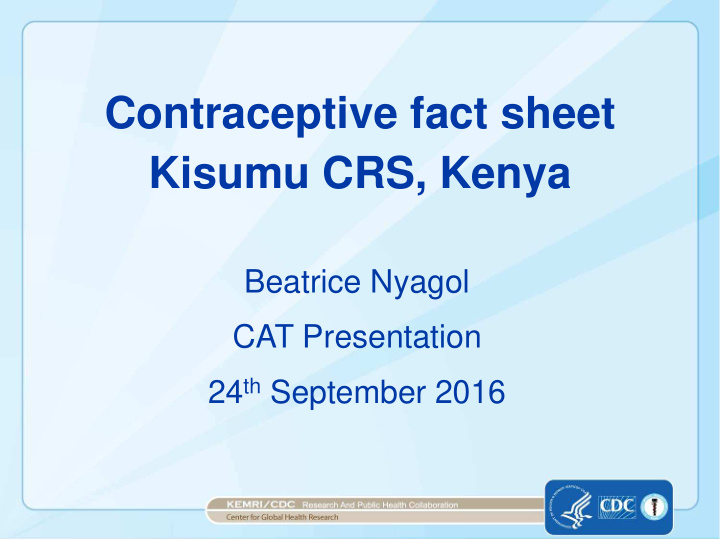



Contraceptive fact sheet Kisumu CRS, Kenya Beatrice Nyagol CAT Presentation 24 th September 2016
Overview Background-Kisumu CRS Family planning situation –Kenya Adolescent Contraception services Barriers/Myths/Misconceptions Clinical Guidelines for contraceptive provision Summary
Modern Contraceptives in Kenya Surgical Contraception Female Sterilization Male Sterilization IUCD (LNG20-IUS/Copper-based) Hormonal Oral Pills(COCs/POPs/ emergency Pills) PO Implants(Jadelle, Implanon,) Injectables (DMPA,NET-EN) Barrier methods( male and female condoms)
Family Planning Status Knowledge of at least one contraceptive method is universal in Kenya More than half of currently married women are using a contraceptive method (58%) and sexually active unmarried women accessing contraceptives is 65% Nationally 15% of women 15-19 years have already given birth In Nyanza 22% of 15-19 years have given birth, median age for first birth is 18.7 years Kenya Demographic Health Survey,2014
Preferred Methods among women % of women sexually active *(unmarried) and all women and contraceptive choice (KDHS 2014) Pill Injectable Implants IUDs 15-19 Yrs* 1.8 14.3 6.0 0.0 20-24 Yrs* 12.2 13.4 1.5 0.0 15-49 Yrs 8.0 26.4 9.9 3.4 Knowledge on emergency contraception was 60% among women • aged 15-49 years ,whereas it was 73.6 among sexually active unmarried women There is a steady increase in the uptake of the more long term • methods, IUDs and Implants but this is more in women aged 25 years and above
Barriers to access Unmet need for FP among adolescents and younger women due to barriers include; Women’s needs and preferences Stigma to access FP services Cost of services Knowledge on availability of services Relationship status Unable to negotiate for safe sex options Complex Socio-behavioral – perception of their social network approval of FP
Myths and Misconceptions Implants Side effects(Infertility, Birth defects) *Can be easily found/seen IUCDs Causes abortions Causes Infections including cancer Promiscuity Pregnancy while in place IUD getting lost
Contraceptive Adherence 31% of contraceptive users discontinue use of the method within 12 months of starting its use IUDs (6 percent) Implants (8 percent) The pill (22 percent) 11% of episodes of discontinuation occurred because of side effects or health concerns, and 5% because the woman wanted to become pregnant KDHS ,2014
Policy context The Kenyan policy on youth contraception is not explicit, resulting in different institutional and individual policies It can also be sighted for the popularity of the less restrictive commercial service sources over health institution-based facilities that otherwise offer more comprehensive services
Policy Context
Summary Unmet need for FP among adolescent girls and young women needs to be bridged Use of long acting methods needs to be promoted Newer methods that are more user friendly and female controlled e.g vaginal rings are much needed MOH needs to provide youth focused services
Asante Sana Questions?
Recommend
More recommend